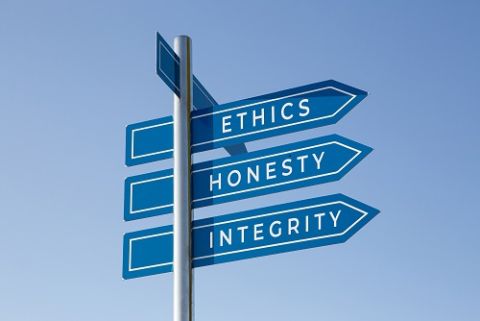A Closer Look: Ethics in Science

Sometimes, scientists find themselves in the middle of ethical debates based on their research or its trajectory. This is especially true for those in the medical sciences and related fields. While some decisions may have a clear choice, others do not as easily divide into “right” or “wrong.” And, sometimes important advancements can only come to fruition in ways that challenge existing beliefs or norms. Even when an option is objectively considered the best choice, it may still have potential risks or downsides. Keep reading to learn about some situations in the history of vaccine science that demonstrate these tough choices and how they were handled by the scientists involved.
Discovering SV40 in polio vaccine
In order to reproduce, viruses must take over an infected cell’s machinery. As such, when scientists create a viral vaccine, they must use a type of cell in which that virus can replicate. For some vaccines, this process utilizes animal cells. In the 1950s, while working at Merck, Dr. Maurice Hilleman discovered that the cells used to produce polio vaccines were contaminated with a monkey virus, called “simian virus 40” or SV40. At the time, it was unknown whether SV40 could harm people, but some studies had suggested it could be linked to cancer. Faced with the ethical conundrum of whether to keep making a vaccine that was preventing children from getting polio or halt the effort until it could be determined whether the contaminating virus posed a risk of cancer, Dr. Hilleman quickly convinced the company to stop making the vaccine. Ultimately, SV40 was found not to cause cancer, but the experience made all vaccine researchers aware of the potential for contaminants and the need to ensure that moving forward, vaccines would not introduce other potential pathogens.
Choosing to use fetal cells in vaccine development and production
As the presence of SV40 in polio vaccine showed, when viral vaccines were grown in cells, there was a risk that the product could be contaminated with viruses – known or unknown. To address this concern, three scientists working at the Wistar Institute in Philadelphia, Leonard Hayflick, Hilary Koprowski and Stanley Plotkin, determined that fetal cells may be a useful alternative for several reasons. One, because the fetal environment is sterile, cells isolated from fetuses would not be contaminated with other viruses. Second, by using cells of human origin, viruses that infect people would be likely to grow well in cells of this type. Third, they already had a source of these cells due to ongoing research into aging; therefore, they did not need a new source for fetal cells.
With this in mind, Dr. Plotkin decided to use fetal cells for his research aimed at developing a vaccine to protect against rubella, also called German measles. Clinicians, like Dr. Plotkin, were aware of the potentially devastating effects if a woman was infected with rubella, particularly if it happened early during her pregnancy. Infected women could lose their babies, or the babies could be born with serious birth defects, like deafness, heart damage, mental delays, damage to the eyes and more.
Although some were wary of or outspoken against the use of fetal cells, Dr. Plotkin’s resolve was firm. Working at the Children’s Hospital of Philadelphia, where he encountered many families affected by rubella infection, he understood well the difficult decisions families were faced with when an infection occurred during pregnancy and the life-altering and potentially deadly consequences for their unborn babies.
Despite the controversy, Dr. Plotkin’s use of fetal cells to grow the rubella vaccine virus was deemed to be safe and effective, and governing councils of religions that prohibit abortion have since issued statements allowing receipt of vaccines made using these cells. Their support centers on the importance of protecting people from infectious diseases as a moral justification.
Staying the course with COVID vaccine clinical trials while thousands were dying
The COVID-19 pandemic presented an ethical dilemma for vaccine regulators, such as those at the U.S. FDA. On one hand, thousands of people were dying each day from this new disease. On the other hand, COVID-19 vaccines would be given to virtually the entire population. FDA scientists knew they had to ensure the safety of any vaccine that would be given to so many people, even if that meant more time had to elapse before a vaccine against this deadly pathogen would be available.
To minimize the time gap and save as many people as possible, the U.S. government created Operation Warp Speed, providing resources to multiple vaccine companies to increase the speed of development of COVID-19 vaccines while not compromising their safety.
While FDA officials experienced a fierce pressure to approve vaccines quickly, particularly in the fall of 2020 as the U.S. Presidential election neared, they knew they needed to remain firm in the demand for well-run and time-appropriate clinical trials. In a recent interview, former FDA vaccine regulator, Marion Gruber, noted, “We were well aware of the gravity of this public health emergency. And we knew we needed to make these vaccines available as soon as possible. But at the same time, not sacrificing the standards for safety and efficacy.”
In sum
As these stories demonstrate, scientists sometimes find themselves in situations where their decisions seem reasonable from the point of view of solving research or scientific problems, but those same decisions may be controversial to others. When science and society intersect, ethical considerations often become part of the equation. What would you have done if you were one of these scientists? Can you think of other scientific topics that have been debated at this intersection?
Related resources
Stanley Plotkin: Pioneering the use of fetal cells to make rubella vaccine
Making Vaccines: Process of Vaccine Development
